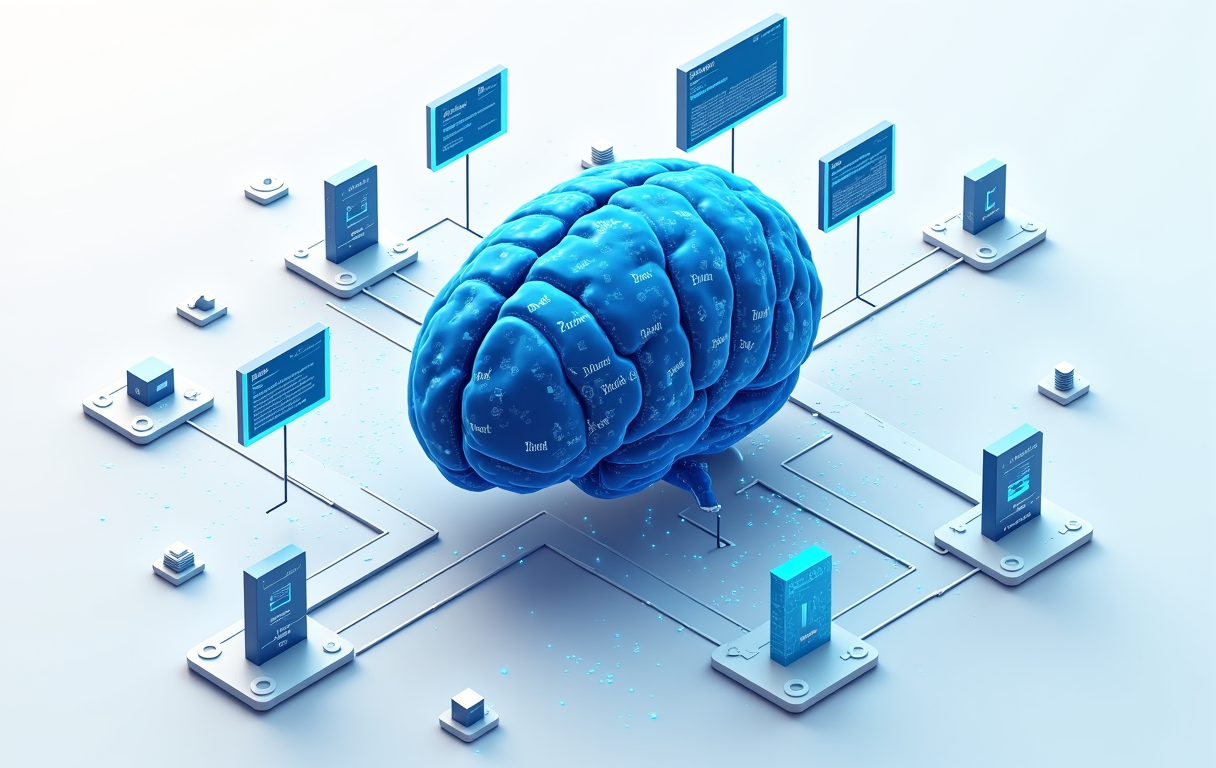AI Agents in Legal Practice: Transforming Law Firm Operations
The legal industry faces unprecedented pressure to innovate. Modern law firms increasingly turn to legal tech solutions, and everyone is talking about AI agents, to maintain competitiveness and improve service delivery. Understanding how these AI agents function within legal contexts is crucial for lawyers and law firm management. Time to shine some light to the topic of Legal AI Agents.
What is an AI Agent?

At its core, an AI agent is a system designed to perceive its environment and take autonomous actions to achieve specific goals. However, the degree of autonomy and decision-making capability varies significantly across different implementations.
Recent developments in artificial intelligence have sparked debates about what truly constitutes an AI "agent."
What others say
Many companies and people who deal with AI are interested in AI agents: Google's (written by Julia Wiesinger, Patrick Marlow and Vladimir Vuskovic) whitepaper on AI Agents represents a significant milestone in understanding the future of AI applications. What stands out is their holistic approach – moving beyond just technical components like models, tools, and orchestration to address practical implementation and integration with existing systems. The paper emphasizes the importance of iterative development and the need to optimize agents for specific use cases. This perfectly mirrors our experience in legal tech, where each law firm has unique requirements and workflows. The paper's analogy of comparing AI agents to a chef continuously improving their skills and adapting to specific requirements makes this complex topic accessible even to non-technical stakeholders. This resonates strongly with our approach at boutiq AI, where we're not just building technology, but crafting solutions that understand and enhance legal work processes. The future of legal tech isn't about replacing lawyers with AI – it's about creating intelligent assistants that augment human expertise with data-driven insights and automated workflows. While the paper covers the technical foundations of AI agents, let's dive deeper into what this means for the legal industry and how it shapes our approach to legal technology.
"Just like humans, Generative AI models can be trained to use tools to access real-time information or suggest a real-world action. For example, a model can leverage a database retrieval tool to access specific information, like a customer's purchase history, so it can generate tailored shopping recommendations."

The Agent Spectrum
Not every AI system qualifies as an agent. A simple decision tree or rule-based system, though potentially useful, lacks the key characteristics of agency: autonomy, adaptability, and goal-oriented behavior.
True AI agents possess:
- Environmental Awareness
- Ability to perceive and interpret their operating context
- Continuous monitoring of relevant changes
- Real-time data processing capabilities
- Autonomous Decision-Making
- Independent evaluation of situations
- Ability to choose between multiple action paths
- Learning from outcomes and adjusting behavior
- Goal-Oriented Behavior
- Understanding of assigned objectives
- Capacity to prioritize actions
- Ability to measure success against goals
The Autonomy Question
The debate around AI agent autonomy centers on a crucial question: How independent should these systems be? While complete autonomy might maximize efficiency, it also introduces risks. Most successful implementations strike a balance, allowing agents to operate independently within clearly defined parameters while maintaining human oversight for critical decisions.
The Anatomy of Legal AI Agents: A Deep Dive into Technical Components

A modern legal AI agent is more than just a single piece of software—it's an intricate system of interconnected components working together to transform legal work. To understand how these agents truly function, let's examine a litigation document analysis agent in detail.
At its foundation, every legal AI agent requires robust document processing capabilities. This starts with an OCR engine that transforms scanned documents into machine-readable text. This text then flows through a natural language processing pipeline that breaks down complex legal documents into meaningful data. The processed information is stored in a sophisticated database architecture that combines multiple approaches: a relational database handles structured case data, while a graph database maps the complex relationships between facts, entities, and events. A document database enables powerful full-text search capabilities across the entire document corpus.
The intelligence layer of the agent represents its cognitive capabilities. The analysis components extract key facts, identify relevant entities, and understand temporal relationships between events. A learning system continuously improves the agent's performance by processing feedback from lawyers and retraining its models. This creates a virtuous cycle where the agent becomes more accurate and useful over time.
Process control forms the backbone of the agent's operations. A workflow engine orchestrates the various tasks, ensuring that documents move smoothly through the analysis pipeline. A queue management system handles resource allocation, while an event processing framework responds to user actions and system events in real-time.
Consider how this works in practice: When a lawyer uploads new case documents, the agent springs into action. The document first passes through OCR and text extraction, creating a clean, searchable version of the content. The analysis engine then identifies key facts, dates, and entities, mapping them into a coherent narrative. The system recognizes temporal relationships and potential contradictions, presenting these insights through an intuitive user interface.
The user interface itself should be built with modern web technologies, providing lawyers with a familiar yet powerful tool. A React-based dashboard presents timelines, document relationships, and key insights. Integration layers connect with existing document management systems and enable exports to standard formats like Word and PDF.
This architecture matters for law firms because it enables both power and flexibility. The modular design allows firms to customize the agent for their specific needs while maintaining enterprise-grade security and scalability. The system can handle cases of any size, from simple disputes to complex multi-jurisdictional litigation.
Most importantly, this technical sophistication serves a practical purpose: enabling lawyers to spend less time on document review and more time on strategic case analysis. The agent becomes an intelligent assistant, augmenting rather than replacing legal expertise.
The future of these agents lies in their ability to learn and adapt.
As they process more documents and receive more feedback, they become increasingly sophisticated in their understanding of legal concepts and relationships. This continuous improvement cycle ensures that law firms investing in AI technology today will see growing returns on their investment over time.
Core Applications of Legal AI Agents
Document Analysis Agents
Modern law firms process thousands of documents daily. Document Analysis Agents transform this labor-intensive process through intelligent automation. These agents scan contracts, identifying key clauses, risks, and obligations automatically. During due diligence, they systematically review vast document repositories, extracting relevant information and flagging potential issues. For legal research, they analyze case law and regulations, presenting relevant precedents and interpretations. Through advanced classification algorithms, they organize documents into logical structures, making information retrieval efficient and intuitive.
Workflow Automation Agents
Workflow automation represents the nervous system of a modern law firm. These agents optimize case management by automatically routing tasks, documents, and approvals through predefined workflows. They maintain vigilant oversight of deadlines, sending timely reminders and escalating urgent matters. Resource allocation becomes data-driven, with agents analyzing workload patterns and suggesting optimal task distribution. The system continuously prioritizes tasks based on urgency, complexity, and available resources, ensuring nothing falls through the cracks.
Client Interaction Agents
Client communication enters a new era with AI agents handling routine interactions. During initial client intake, these agents collect and verify basic information, ensuring compliance requirements are met before lawyer involvement. They manage routine queries about case status, document requirements, or procedural questions, providing instant, accurate responses. Scheduling becomes seamless, with agents coordinating meetings while respecting complex availability constraints. Status updates are automated yet personalized, keeping clients informed without consuming lawyer time.
Implementing AI Agents in Your Law Firm: A Strategic Approach
Starting Smart: The Assessment Phase
Successful AI implementation begins with thorough assessment. Law firms must first identify repetitive tasks consuming valuable attorney time. Common candidates include document review, compliance checks, and standard correspondence. This mapping exercise should quantify time spent on each task and potential automation benefits.
Next, evaluate your firm's technical foundation. Document your current software stack, including document management systems, practice management tools, and communication platforms. This inventory reveals integration requirements and potential technical barriers.
Staff readiness forms the final assessment pillar. Survey your team's technical proficiency and openness to AI adoption. Resistance often stems from misconceptions about AI replacing jobs rather than enhancing capabilities.
Making the Right Choice: Selection Criteria
Security stands paramount in legal AI selection. Your chosen solution must meet stringent data protection standards and comply with legal ethics rules. Verify encryption standards, data handling practices, and compliance certifications.
Integration capability determines implementation success. The AI solution should seamlessly connect with your existing tools, particularly your document management system. APIs and standardized data formats facilitate smooth information flow between systems.
Consider scalability early. Your chosen solution should grow with your firm, handling increased document volumes and user numbers without performance degradation. Factor in both technical scalability and licensing costs.
Conduct thorough cost-benefit analysis. Beyond license fees, consider implementation costs, training requirements, and potential productivity gains. Calculate ROI based on time saved and new revenue opportunities.
Execution: Implementation Steps
Begin with a focused pilot program. Select a specific practice area or task type for initial implementation. This controlled environment allows for testing and refinement without disrupting firm-wide operations.
Invest in comprehensive staff training. Include both technical training on the AI tools and broader education about AI capabilities and limitations. Create clear documentation and establish support channels for questions and issues.
Monitor performance rigorously. Track key metrics like time saved, error rates, and user adoption. Use both quantitative data and qualitative feedback to assess success.
Regular feedback collection drives continuous improvement. Establish formal channels for user feedback and schedule periodic reviews. Use this input to refine workflows and identify additional training needs.
The Future Landscape of Legal AI Agents
Emerging Trends
Natural language processing in legal AI is evolving rapidly, approaching human-level understanding of complex legal documents. Advanced NLP enables agents to grasp nuanced legal arguments, identify implicit relationships between cases, and understand contextual meanings in different jurisdictions.
Predictive analytics represents the next frontier. AI agents now analyze historical case data to predict litigation outcomes, estimate settlement ranges, and forecast judicial tendencies. This capability transforms strategic decision-making, enabling data-driven case strategy and resource allocation.
Document generation is moving beyond templates. Modern AI agents create sophisticated legal documents by understanding context and precedent. They adapt language based on jurisdiction, incorporate relevant case law, and maintain consistent argumentation throughout complex documents.
Preparing Your Law Firm
These changes aren't just technological - they represent a fundamental shift in legal practice. Firms that prepare systematically will thrive in this new landscape.
AI literacy must become a core competency. Lawyers need practical understanding of AI capabilities and limitations. This doesn't mean becoming technical experts, but rather developing sufficient knowledge to effectively leverage AI tools in their practice.
Change management requires systematic approach. Identify AI champions within practice groups, create clear communication channels, and establish metrics for adoption success. Address concerns proactively and celebrate early wins to build momentum.
Ethical guidelines must evolve with technology. Develop clear policies for AI use in client matters, data handling protocols, and oversight mechanisms. Regular reviews ensure alignment with evolving legal ethics rules and professional responsibilities.